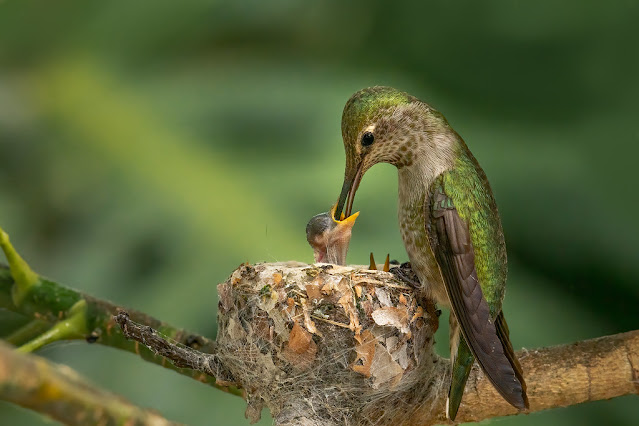Home Hummingbird The Science Behind Hummingbird Feeding
The Science Behind Hummingbird Feeding
Bird Of The World February 19, 2023 0
A remarkable genus of birds, hummingbirds are distinguished by their small size, iridescent feathers, and extraordinary flight ability. The peculiar feeding habits of these little organisms, however, are what distinguish them from other birds. This article will examine hummingbird feeding behaviors, including what they consume, how they consume it, and how to entice them to your yard.
 |
| The Science Behind Hummingbird Feeding |
The hummingbird's anatomy
One of the tiniest bird species in the world, the hummingbird weighs only 2.5 grams in its smallest species. Their extraordinarily quick metabolism, which enables them to consume food quickly and effectively, is what permits them to grow so little. Hummingbirds are designed to fit into blooms and extract nectar, thus they have long, slender bills. They can also reach deep inside blooms to extract nectar thanks to their long, flexible tongues. Hummingbirds consume nectar as well as insects and spiders, which give them the necessary protein and other nutrients.
What Do Hummingbirds Eat?
Nectar is the hummingbirds' main dietary source. Nectar, a sweet, sugary liquid found in the flowers of numerous plants, is a natural resource. Red or orange blooms, which are frequently tubular in shape and carry a lot of nectar, are highly preferred by hummingbirds. Hummingbirds eat nectar as well as insects and spiders, which give them protein, amino acids, and other vital elements. When nectar is sparse, insects and spiders also contribute to the hummingbird's diet.
Feeding Behavior
Hummingbirds are able to hover in midair while consuming nectar from flowers because to their distinctive eating technique. Its strong wings, which may beat up to 80 times per second, enable this activity. Hummingbirds have the ability to hover as well as fly forward, backward, and even upside down. Hummingbirds hunt for food using their sharp vision and keen sense of smell, and they will fiercely defend their area from other hummingbirds.
Migration and Feeding Patterns
Many species of hummingbirds migrate across great distances every year to nest and find food. Hummingbirds depend on the nectar-producing plants and insects that are present along their migratory paths to provide them the energy they require to complete their flight. Hummingbirds modify their feeding habits as the seasons change to take advantage of fresh food sources. Hummingbirds concentrate on eating flower nectar in the spring and summer, switching to eating insects and spiders in the fall to get ready for their lengthy migration.
How to Get Hummingbirds to Visit Your Yard
There are a few things you may do to entice hummingbirds to your yard. Start by growing nectar-rich flowers in your garden, like trumpet vine, cardinal flower, and bee balm. Hummingbird feeders can also be hung up and filled with a solution of four parts water to one part white granulated sugar. To stop the sugar water from fermenting and growing dangerous bacteria, make sure to replace it every few days.
Conclusion
Hummingbirds are extraordinary birds with special feeding habits that enable them to survive in a range of habitats. We may contribute to the protection of these lovely and significant creatures by learning more about their eating habits and what they require to live. The hummingbird is a true wonder of the animal kingdom, whether you're a birdwatcher, a gardener, or just someone who appreciates the beauty of nature.
Frequently Asked Questions about Hummingbird Feeding Habits
What do hummingbirds eat?
Hummingbirds primarily feed on nectar from flowers. They also eat insects and spiders for protein, particularly when feeding their young.
How often do hummingbirds feed?
Hummingbirds feed frequently throughout the day and may visit hundreds of flowers each day to gather nectar. They may also consume insects and spiders as they fly.
How can I attract hummingbirds to my garden?
To attract hummingbirds to your garden, provide a variety of nectar-rich flowers, such as trumpet vines, bee balm, and salvia. You can also put up hummingbird feeders filled with a sugar-water solution.
How can I make hummingbird food?
To make hummingbird food, mix one part white granulated sugar with four parts boiling water. Stir until the sugar is completely dissolved and let the solution cool before filling your feeder.
Are there any plants that are harmful to hummingbirds?
Yes, there are some plants that are toxic to hummingbirds, including foxglove, larkspur, and monkshood. It's important to research which plants are safe for hummingbirds before planting them in your garden.






Post a Comment